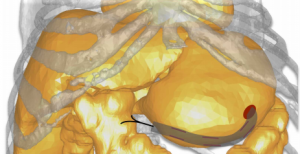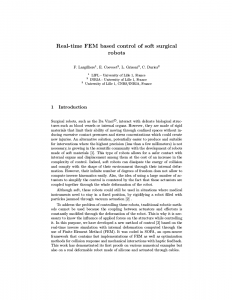Real-time FEM based control of soft surgical robots
F Largillière, E Coevoet, L Grisoni, C Duriez.
Introduction
Surgical robots, such as the Da Vincic , interact with delicate biological structures such as blood vessels or internal organs. However, they are made of rigid materials that limit their ability of moving through confined spaces without inducing excessive contact pressures and stress concentrations which could create new injuries. An alternative solution, potentially easier to produce and suitable for interventions where the highest precision (less than a few millimeters) is not necessary, is growing in the scientific community with the development of robots made of soft materials [1]. This type of robots allows for a safer contact with internal organs and displacement among them at the cost of an increase in the complexity of control. Indeed, soft robots can dissipate the energy of collision and comply with the shape of their environment through their internal deformation. However, their infinite number of degrees of freedom does not allow to compute inverse kinematics easily. Also, the idea of using a large number of actuators to simplify the control is countered by the fact that these actuators are coupled together through the whole deformation of the robot. Although soft, these robots could still be used in situations where medical instruments need to stay in a fixed position, by rigidifying a robot filled with particles jammed through vacuum actuation [2] . To address the problem of controlling these robots, traditional robotic methods cannot be used because the coupling between actuators and effectors is constantly modified through the deformation of the robot… [read more]




